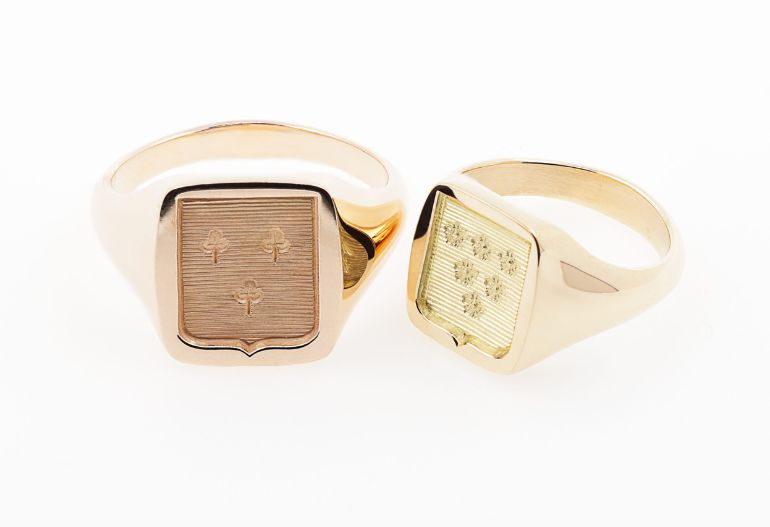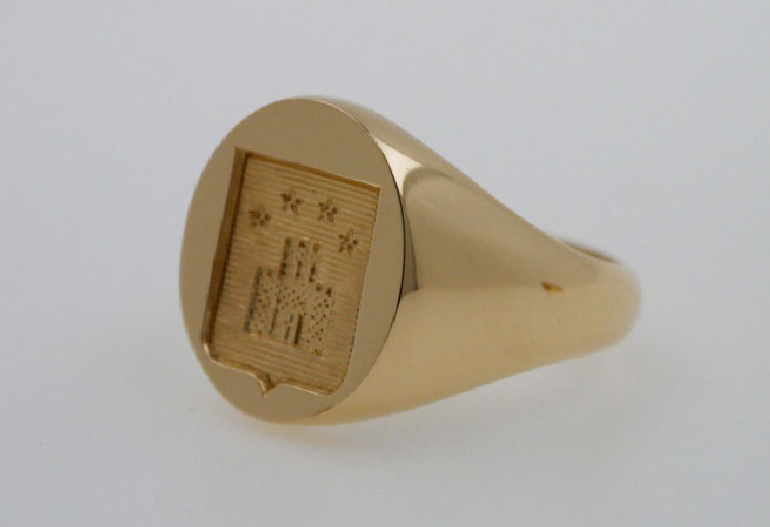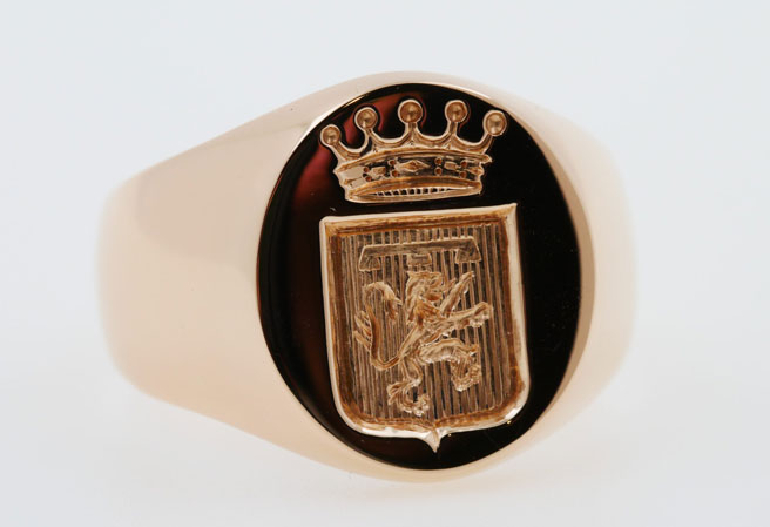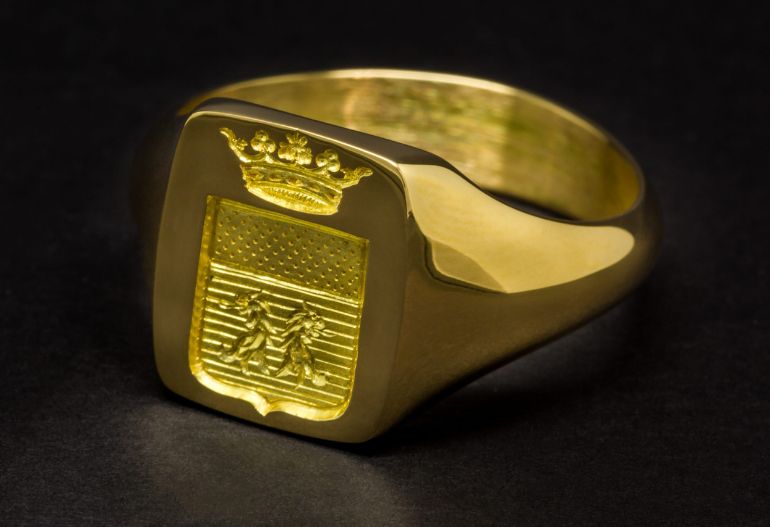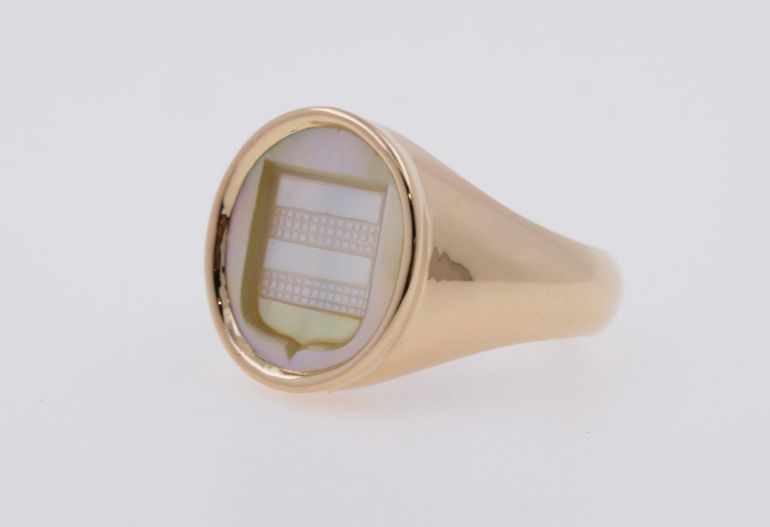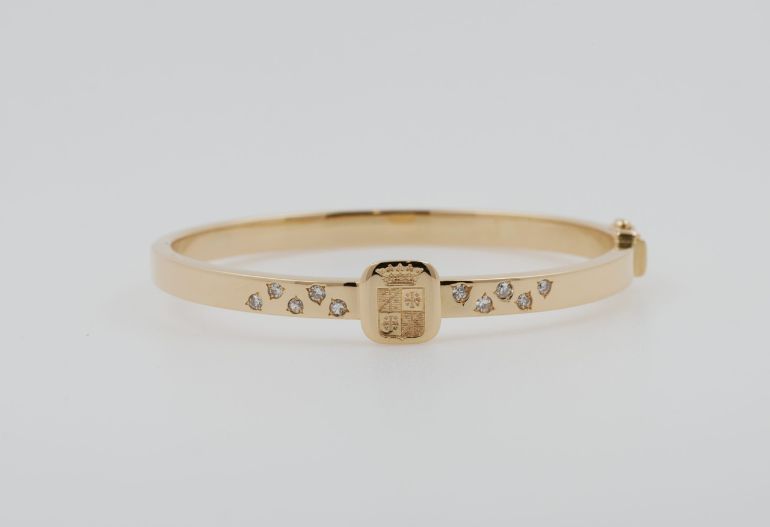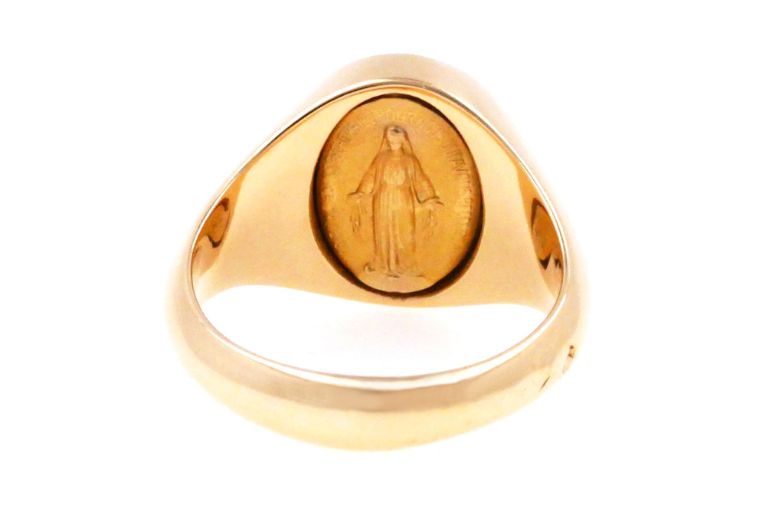Heraldic signet rings
Every piece has been custom-made in our workshop in Nantes. If you're looking to surprise a loved one—or treat yourself —with a unique piece of jewelry , come visit us at the atelier or give us a call at +33 (0) 2 85 52 38 63
A bit of history
The history of signet rings spans over 4,000 years, dating back to Ancient Egypt, where rings were adorned with hieroglyphs and served as symbols of social rank, power, and tools to seal commercial agreements.
In France, signet rings made their appearance during the Middle Ages and were then crafted exclusively in yellow gold. Hieroglyphs gave way to family crests and coats of arms engraved on the rings. This highly symbolic piece of jewellery was worn by the nobility, who used their ring to seal documents with wax, thus authenticating them with their personal heraldic emblem. In an era marked by widespread illiteracy, this system allowed the sender of a letter to be easily identified.
As literacy became more widespread and handwritten signatures took precedence, this type of ring—also called a “sigillary” ring—gradually lost its practical use. Wax seals were slowly replaced by signatures, and the signet ring fell out of favor. It wasn't until the 18th century that it regained popularity, first among men. Still steeped in social status, it was especially prized by the elite as a way to showcase noble lineage. It became a powerful symbol of heritage and family history, passed down from generation to generation. During this period, the signet ring evolved into a true fashion accessory.
Evolution of the heraldic tradition
From the 19th century onwards, gold was no longer the exclusive material for heraldic signet rings. Family crests began to be engraved on precious stones using the intaglio technique, giving rise to new aesthetic possibilities. It was also during this period that women started wearing signet rings, typically on the left rosey finger.
Traditionally, the signet ring is worn on the left ring finger by the eldest child of the family—the heir and bearer of the family name and coat of arms. Younger siblings, or cadets, would wear it on the right rosey. Today, however, it is more commonly worn on the left ring finger by many men, regardless of their birth order.
Since the fall of the French monarchy, signet rings have become more widely accessible and are no longer reserved for a specific social class. Anyone can now create their own coat of arms or enlist the help of a heraldist to design one, in accordance with heraldic traditions.
In recent years, rose gold has also made its way into the world of signet rings and has become a highly sought-after material for its warm and elegant hue.
SYMBOLISM OF THE COAT OF ARMS
In France, women's shields are traditionally shaped like a lozenge or oval, reflecting a long-standing heraldic convention.
For men, the most common forms are the scutiform (shield-shaped) designs, either in the old or modern proportions, depending on family tradition and personal preference.
The coats of arms of noble families can be “adorned” or “topped” with heraldic elements known as "timbres." These may include: • A crown, if the family holds a noble title, • A helmet (heaume), often accompanied by mantling (lambrequins), for knightly families without a noble title, • Or a mantle, reserved for princes and sovereigns. These elements add layers of meaning to the blazon, reflecting the family’s history, rank, and social standing.
engraving
Armorial signet rings are engraved in intaglio (recessed or negative engraving) so that the family crest appears in the correct guideation when pressed into wax. This traditional technique ensures that the seal is both functional and symbolic.The method used, known as line engraving or “taille douce”, involves delicately incising the metal to create detailed shapes and relief. This precise craftsmanship enhances the design’s depth and authenticity, giving the ring both aesthetic and historical value.
A RARE AND DISAPPEARING CRAFT
This remarkable and demanding profession—listed in France’s Inventory of Intangible Cultural Heritage—requires exceptional dexterity, precision, and meticulous attention to detail. These true artists, known as engravers or sculptors, carry out their delicate work using a variety of specialized tools and traditional burins. Sadly, the art of hand engraving is becoming increasingly rare, and the number of skilled engravers in France continues to decline. As a result, production times have lengthened and now require patience—typically between 4 to 6 months depending on the time of year.
Today, many engravings are done by laser for speed and consistency. However, in honor of ancestral craftsmanship, our workshop has chosen to preserve and promote traditional hand engraving, carried out by a certified and highly skilled artisan engraver. These hand-engraved pieces are truly one-of-a-kind, and the depth of their carving ensures they will endure for generations.
THE SPECIALTY OF MAISON GRIFFON JOAILLIERS
Bespoke creation also allows for a touch of creativity and imagination within the highly codified world of heraldic signet rings. At Maison Griffon, tradition meets innovation—rings can be crafted in bi-metal designs, feature ebony inlays, or even be entirely reimagined as a bracelet rather than a traditional ring. A world of possibilities opens up, where centuries-old heritage blends seamlessly with modern design to create truly exceptional and personal pieces.
Heraldic Signet Ring in Rose Gold, Rose gold heraldic signet ring featuring a domed bezel, a crown and a modern-style shield, with an inlaid piece of ebony set into the band.
Armorial signet ring with a modern-style shield engraved into mother-of-pearl.
Two-tone signet ring with a platinum bezel and a yellow gold band, featuring a crown, a modern-style shield, and mantling.
Coat of arms featured on a cuff-style bracelet, adorned with diamonds.
Addition of a Miraculous Medal beneath the family coat of arms.



